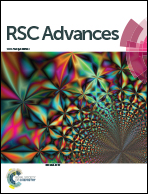Transition-metal-free solid phase synthesis of 1,2-disubstituted 4-quinolones via the regiospecific synthesis of enaminones†
Abstract
Herein, the transition-metal-free economical solid phase synthesis of 1,2-disubstituted 4-quinolones has been developed via the novel regiospecific synthesis of enaminones. Notably, a wide range of enaminones were synthesized via a silica-supported solid-phase reaction in good to excellent yields. The transformation of enaminones to 1,2-disubstituted 4-quinolones and N-methyl-2-aryl-4-quinolone alkaloid was achieved in high yield via an alumina-supported solid phase reaction. In addition, all the synthesized compounds were isolated directly in their pure form from the reaction mixture using an easy workup procedure.


 Please wait while we load your content...
Please wait while we load your content...